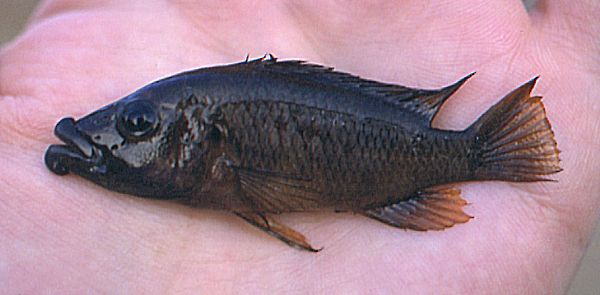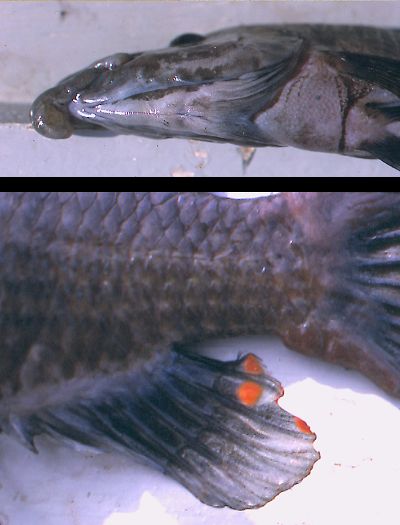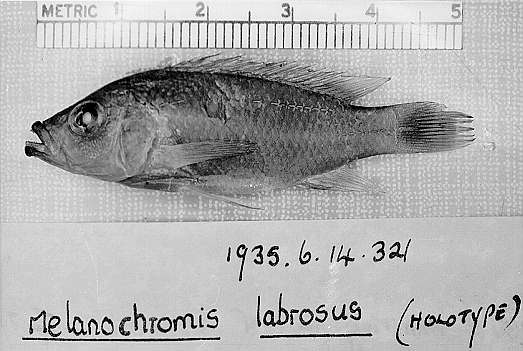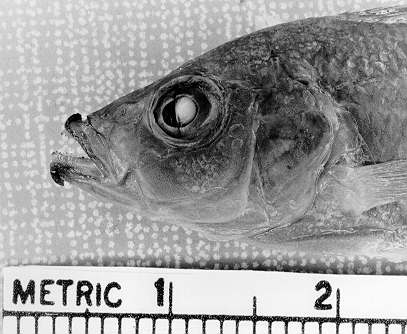

Above:
Abactochromis labrosus (Trewavas, 1935) is a somewhat enigmatic Mbuna species,
a rarely encountered skulker on rocky shores. The subadult individual above was about
55 mm (2.2 inches) standard length (SL, excluding caudal fin) and 67 mm (2.7 inches)
total length. It was collected (part of collection field number MKO80-72) on 21 July 1980
by M.K. Oliver, K. McKaye, and T. Kocher using rotenone and SCUBA at Nkhata Bay, Malawi,
in the north bay along the peninsula, about 15 meters from its tip. We spread the
rotenone to a depth of 50 feet (15 m) on this rocky shore, which lacked any macrophytes
(higher plants). Photo copyright © by M.K. Oliver.
It has been evident to many scientists and aquarists for years that this species, originally named Melanochromis labrosus,
is not closely related to the other cichlids placed in the genus Melanochromis. It's not just
that it is unusual, with those enlarged, rubbery lips; those could have evolved in a species of Melanochromis,
as they have in many other cichlids. The most important feature preventing A. labrosus from inclusion
in Melanochromis is that it has a color pattern only of primitive vertical bars,
instead of the highly distinctive pair of horizontal stripes (typically with opposite light/dark arrangement
in males and females) found in Melanochromis; for example, in M. auratus.
In addition, "M." labrosus has more gill rakers, and fewer vertebrae, than proper members of the genus Melanochromis.
Nor could this species be plausibly classified in any other existing genus.
There has even been disagreement as to whether it is a member of the Mbuna
group, or of the "hap" (non-Mbuna Malawi haplochromine) group. I myself once believed it was a "hap," not an
Below: A large adult male Abactochromis labrosus (the largest ever collected) is shown
in overall lateral view and in close-ups of the underside of the laterally compressed head and of the
anal fin with its remarkable orange-red eggspots (all photos copyright © by M.K. Oliver).
This fully grown individual measured 119 mm (4.7 inches) SL, which must be close to
the maximum size this species attains in the wild. The fleshy median lobes of the lips
have been moved forward to show their length and fullness. Matt Arnegard and I discovered that
these lips are densely covered with taste buds; see our paper for the details. This individual
was collected from trammel and experimental gill nets set overnight 24-25 July 1980 (MKO80-84),
by the same people as for the smaller fish depicted above, again in Nkhata Bay (this time
off the southern shore of the south bay near emergent offshore rocks, some 75 meters from shore).
Capture depth ranged from 6 to 45 meters; unfortunately, the exact depth at which this fish was
caught is unknown. This was a rocky locality devoid of any macrophytes and exposed to wave action
from easterly and southeasterly winds. (Text continued below photo.)
Two other individuals (not photographed) were collected on 23 July 1980 (part of MKO80-79)
by M.K. Oliver, K. McKaye, and T. Kocher. They were captured with SCUBA at Nkhata Bay,
off the tip of the peninsula separating the north and south bays, using rotenone dispersed
among rocks in a depth of 17-20 meters (55-65 feet). At this locality, the rocky shore
dropped off rapidly, at an angle of 45°-75°. Higher plants were completely lacking;
filamentous algae grew to a length of 5 mm (0.2 inches).
This species has sometimes been confused with a "hap," the only distantly related
Placidochromis milomo Oliver, which, among other
differences, has larger thoracic scales, reaches a much larger size, and has only
four vertical bars below the dorsal fin (vs. about seven in A. labrosus).
A couple of major American museums have P. milomo specimens whose ichthyologist
collectors deposited them as "Melanochromis labrosus"! This further illustrates
the Mbuna-versus-"hap" confusion affecting this puzzling taxon, the only one of the
800 or so cichlids in Lake Malawi whose placement has been confused to this degree.
Abactochromis labrosus is rarely seen. The commercial aquarium collector and his staff
handle only 5-10 per year, out of approximately 75,000 fish (the late Stuart Grant, in litt. 6/1999).
This distinctive cichlid bears little resemblance to other Mbuna, with its laterally compressed head bearing
somewhat enlarged lateral line pores, a somber color pattern of muted vertical bars (although
breeding males become more colorful), and solitary, wandering habits. In fact, this unusual
behavior — almost as though the fish is an outcast, banished from cichlid society —
partly inspired our choice of the new generic name. "Abactochromis" is derived from the Latin
"abactus" (ab-, away from; actus, driven), meaning driven away, banished, expelled; and the
widely used root "chromis," seen in many a haplochromine generic name. A second meaning that
our name alludes to is our removal of this species from its original genus; we "banished" it from
Melanochromis, where it had mistakenly remained for 75 years, to its very own genus. Its
phylogenetic position among the Mbuna is unknown at this time. There are some hints that it
may be a basal mbuna that split off early in the history of the clade.
Ribbink et al. (1983) reported this species (then still
called a Melanochromis) from shallower water than where I found it, less than 8 meters
(26 feet) in depth. These authors note that "[i]t usually remains hidden among the rocks and
appears to be rare. However, a rotenone sample at Maingano [Likoma Island] revealed that there
are more M. labrosus among the rocks than indicated by transects and by observation."
Ribbink et al. were able to observe its feeding behavior: "It moves from rock to rock placing
its narrow mouth and large lips in cracks and grooves, which it seals, and then sucks the
benthic Invertebrata and loose Aufwuchs from the sealed area."
Konings provides additional observations and speculation about this interesting species:
However, Matt Arnegard and I had to disagree with Ribbink and Konings about the function of the soft, enlarged
lips. We believe they may be too delicate for constant friction against rocks. Our discovery
that the lips are densely packed with taste buds suggests an alternative explanation; these lips,
much like the barbels of catfishes, may allow A. labrosus to sense prey items deep in dark
cracks by tasting them. Or, perhaps the two proposed functions are not mutually exclusive. A well-designed
experiment could settle the matter. In any case, Abactochromis labrosus is an unusual
and highly intriguing cichlid.
Two photos below:
The holotype of Abactochromis labrosus (BMNH 1935.6.14:321). Below the whole specimen
is a closeup of the holotype's head. As may be seen by comparing the preserved holotype with the
photos of even the smaller freshly collected specimen (above), the lips and their median lobes
have shriveled considerably in alcohol. Black and white photos copyright © by M.K. Oliver.
Abactochromis labrosus
by Michael K. Oliver, Ph.D.
Mbuna. (I have changed my mind; the balance of evidence indicates it most likely does belong with the Mbuna.)
Therefore, Dr. Matt Arnegard and I recently described a new genus, Abactochromis, to contain it
(Oliver & Arnegard, 2010). You can
download this paper to read for yourself;
it also contains illustrations of A. labrosus with anatomical details, a discussion of the
characteristics supposed by many writers to define the Mbuna group (it turns out that these features don't
do it satisfactorily), a survey of the number of vertebrae in all 13 Mbuna genera, and a key to these genera.

 It has been (rarely) seen or collected on rocky shores throughout the lake, with the rather
startling exception of the shallow south end, Cape Maclear and the southern arms. One can
only speculate as to why it is absent there, where there is ample rocky habitat and where
other widely distributed Mbuna such as Labeotropheus species are found. Matt and I
propose one possible answer in our paper.
It has been (rarely) seen or collected on rocky shores throughout the lake, with the rather
startling exception of the shallow south end, Cape Maclear and the southern arms. One can
only speculate as to why it is absent there, where there is ample rocky habitat and where
other widely distributed Mbuna such as Labeotropheus species are found. Matt and I
propose one possible answer in our paper.
At Chitande Island I once found an orange M. labrosus, a polychromatic form of this
normally brown coloured species [the photo accompanying this statement shows an individual
colored a somber, dull orange and showing muted vertical bars; it is not similar to on
orange morph of, say, a Labeotropheus].... M. labrosus is seen sporadically
all around the lake but is found most frequently at islands and along the north-eastern
shores, north of the Ruhuhu River. This distribution pattern is characteristic of an old
species [I agree] with a narrowly defined specialisation.... Both sexes are dark brown,
but males may have a reddish sheen overlying the brown ground colour. Another characteristic,
not seen in any other mbuna, is the strongly laterally compressed body. Like the similarly
compressed Altolamprologus compressiceps of Lake Tanganyika, it is thus able to
penetrate into narrow slits and cracks between the rocks. The soft fleshy lips are used
to seal off the crack while the prey is sucked out of its shelter. Like other laterally
compressed cichlids with swollen lips (eg Lichnochromis acuticeps, Protomelas
ornatus), it feeds primarily from horizontal cracks and slits inside caves. In order
to penetrate such cracks it turns on its side just before entering. M. labrosus moves
in and out of caves searching for small mbuna and crustaceans. Males do not defend a
spawning site, but aggressive behaviour (defence of the feeding site) is displayed by
both male and female when two conspecifics
meet. (Konings, 1995: 172-173)



Last Update: 28 October 2010
Web Author: M. K. Oliver, Ph.D.
Copyright © 1997-2021 by M. K. Oliver, Ph.D. - ALL RIGHTS RESERVED